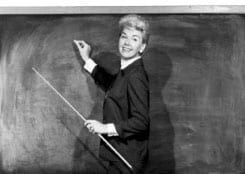Recently I went on a trip to a marketing conference, where I gave a presentation on video production tips. My talk was all about helping people improve their web videos, and in this video I’ll go over the main points that I covered.
Listen to the audio version: [powerpress]
00:18 Fast Web Formula
00:29 Audio
01:38 Lighting
02:13 Framing
I attended Fast Web Formula in Sydney and it was a great conference. I was lucky enough to be asked to give a talk on how people can improve their ‘face to camera’ videos.
There’s so much I could cover on this topic, but since I only had a small amount of time, I took it as a challenge to come up with the simplest tips that would have the most impact. This is advice you can use right now, which will definitely improve the quality of your videos.
How to improve the quality of your web videos:
#1: Audio
With audio, the best thing you can do is try to reduce outside noise as much as possible. There are a few things that can help you do this.
First, try not to use the onboard microphone on your camera. Since the camera is going to be placed away from you, it will pick up a lot of noise from your surroundings.
Invest in a lapel mic which is a small microphone that will clip to your shirt or jacket. Having a microphone nice and close to you will cut out a lot of that excess noise. You could also use a shotgun microphone that you can get as close as possible to your subject without being in the frame. This will let you have professional sounding audio that will boost the quality of your video. Making sure you are in a quiet room is a must. Try to record in a room with closed windows, that has no air-conditioning unit basting away, and that is far from any outside traffic sounds.
It’s these little things that will go that extra mile in helping your video.
#2: Lighting
In terms of lighting, knowing the principles of 3-point lighting is your best friend. Position one light as the key light, which is the brightest light, to one side of the camera, aimed at your face. The fill light, which will be a little dimmer than the key, is placed on the other side of the camera to give your face depth, but also get rid of any deep shadows. The backlight is placed behind you, just out of frame, and this should illuminate your shoulder and behind your head to separate you from the background.
If you don’t have access to a lighting system, a good tip to remember is to not sit between the camera and a bright light source. This will make you appear dark in the frame. Sit so that the camera is between you and the light source, this will make sure you’re audience is able to see you properly.
#3: Framing
When framing yourself in the shot, make sure that your eyes lay roughly 1/3 down the screen from the top. This will give a much more aesthetically pleasing look to your video as it adheres to the ‘rule of thirds’. Also, remember to give your self a little bit of space between the top of your head and the top of the frame. Not too much, but enough so that your head doesn’t touch the top and you don’t have a huge space above you.
Placing yourself slightly to the right or left of the screen, will also give the video a nicely composed feel. Keep your background in mind as well. Clean up any clutter and position anything that can be seen nicely.
It’s another small thing, but having a messy, unprofessional looking space to film in will impact the quality of your video.
If you follow these simple golden rules, you will be amazed at the improvement that can be made to your videos. For more helpful ideas to improve your web video productions, subscribe to my YouTube channel and you’ll never miss an update.

Ryan Spanger is one of Melbourne’s most respected and sought-after video production professionals. Ryan founded Dream Engine in 2002, and specialises in helping medium to large corporates, government departments, and the non-profit sector to connect with their audience more effectively by using video.

